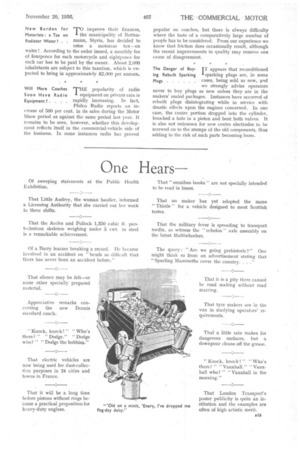One Hears
Page 29

If you've noticed an error in this article please click here to report it so we can fix it.
Of sweeping statements at the Public Health Exhibition.
That Little Audrey, the woman haulier, informed a Licensing Authority that she carried out her work in three shifts.
That the Accles and Pollock 1,350 cubic ft. pantechnicon skeleton weighing under 5 cwt. in steel is a remarkable achievement.
Of a Barry learner breaking a record. He became involved in an accident on "bends so difficult that there has never been an accident before.
That silence may be felt—or some other specially prepared material.
Appreciative remarks concerning the new Dennis standard coach.
"Knock, knock!" "Who's there? " "Dodge." "Dodge who? " "Dodge the bobbies."
That electric vehicles are now being used for dust-collection purposes in 24 cities and towns in France.
That it will be a long time before pistons without rings become a practical proposition for heavy-duty engines. That "omnibus books" are not specially intended to be read in buses.
That no maker has yet adopted the name " Thistle " for a vehicle designed to meet Scottish tastes.
That the military fever is spreading to transport media, as witness the " echelon " axle assembly on the latest Multiwheelers.
The query : "Are we going prehistoric?" One might think so from an advertisement stating that " Spurling Mammoths cover the country. . . ."
That it is a pity there cannot be road making without road marring.
That tyre makers are in the van in studying operators' requirements.
Tha.i a little rain makes for dangerous surfaces, but a downpour cleans off the grease.
" Knock, knock ! " "Who's there? " "Vauxhall." "Vauxhall who? " "Vauxhall in the morning."
That London Transport's poster publicity is quite an institution and the examples are often of high artistic merit.




























































































